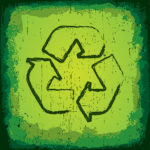The three R’s

My parents instilled in my family a sense of stewardship over nature that has stuck with me through the years. As we grew up in Northern Michigan, we were taught to recycle, use our grandmother’s compost pile, and practice "Leave No Trace" camping and hiking.
As an adult I’ve tried to expand on these lessons to be as Earth-friendly as I can in the current day and age. I keep my water bottle on me to eliminate the need for single use cups, I’ve found ways to reduce my carbon footprint, and I try to support sustainable businesses.
All of these things help, but the biggest way to help the environment are the three R’s: Reduce, Reuse, and Recycle.

The first R: Reduce. This one is probably the easiest to accomplish. There are so many ways to reduce the amount of waste that your household produces. Single-use plastics are the biggest household pollutant worldwide. Reusable sandwich bags and storage containers are an easy and affordable way to cut back on single use plastics. Even just bringing reusable shopping bags to the grocery store can help cut down on the roughly 1.8 billion plastic bags that are disposed of each WEEK in the United States. Keep in mind though, that just like other reusable storage, reusable grocery bags do need to be washed regularly. Swapping out beeswax wraps for plastic wrap is another great way to cut down on single-use plastics.

The second R: Reuse. Keeping and reusing things like boxes and gift bags is a great way to prevent waste. I also like to save glass jars from foods that have been used up. If you soak the labels off and wash them out, they’re great for holding pantry staples like coffee beans, rice, and dried beans. Glass jars also work great as small planters; line the bottom with lava rocks or gravel for drainage before filling up with potting soil and go for it! Another simple way to reuse things is taking old t shirts with rips or stains and cutting them up to make rags for cleaning and dusting.

The third R: Recycle. Recycling may seem like the easiest thing on this list, but many municipalities have stringent guidelines for what can and cannot be recycled which aren’t always clear. I live in the city of Detroit, which doesn’t necessarily have a citywide recycling program. Now as I have to sort and take my recyclables to a processing plant myself there are a few things to remember. First of all, any cardboard or paper that has food on it cannot be recycled. The same goes for containers that have not been thoroughly cleaned out. The most commonly recycled plastics are plastics #1, #2, #4, #5, #6, and #7, so make sure you check the numbers before blindly throwing things into the bin! The biggest lessons here are to check your local guidelines before trying to recycle things.

Working as we do in the Green Industry makes us a natural fit for modeling environmentally-friendly practices both at work and at home. Our families, clients, neighbors and friends can be positivly influenced by our example.

